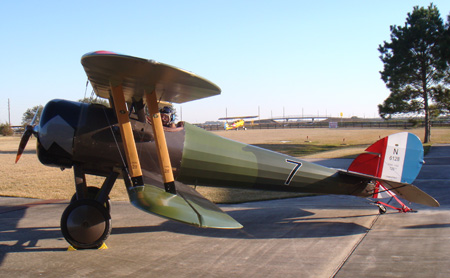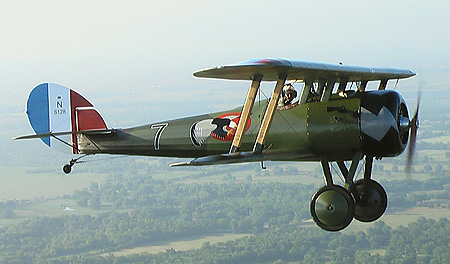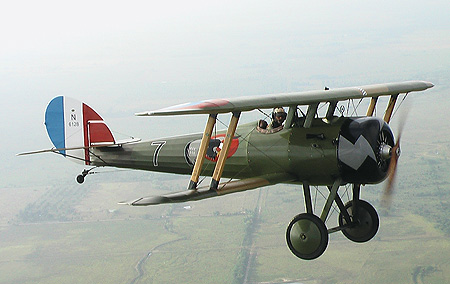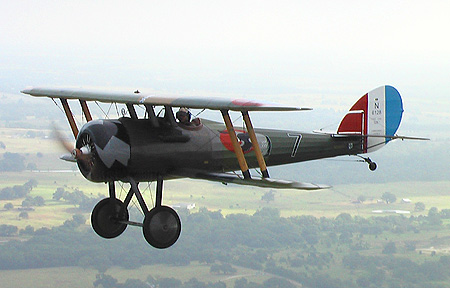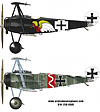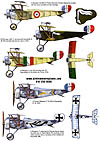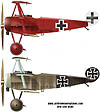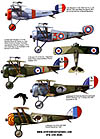 |
|
Pilot Report
Nieuport 28 Kit:� Airdrome Aeroplanes, Engine: Rotec R2800 7-cylinder radial, 110 HP Equipment List: Radios � Micro Air M760
Transceiver, T2000 S FL Transponder w/mode C Navigation GPS � Garmin 396/XM
Sat Radar Elevator Trim Steerable Tail Wheel � MATCO Hydraulic Disc Heel Brakes �
MATCO Taxi, Landing Light Position/Strobe
Lights � Kuntzleman Electronics, Inc. Propeller � Culver 47X79
(Cruise) Carb Heat Cabin Heat Fuel Tanks � Fuselage 20
GAL/upper wing 10 GAL Total:
30 GAL (Approx 4 hrs/15 min duration) Oil Cooler (Heavy Duty) Halon
Fire Extinguisher ELT-ACK Smoke System Test Profile: 1.
Engine starts/operations/shut down. 2.
Taxi aircraft with/without brakes 3.
High speed taxi 4.
Takeoff, climb, cruise, turns, descent and landing 5.
Stalls, power on/off 6.
Lazy 8, Chandelle, combat maneuvers, upset and unusual
attitudes 7.
Max performance takeoff/shortfield
landing 8.
Emergencies � engine failure/malfunction, electrical
failure, Background:� We
started the Nieuport 28 on 16 March 2008 in I asked for two test areas in
case the weather was too poor to test an open cockpit airplane in MO in the
winter.� It was, so I decided to ship the
aircraft to Ground Handling Test:�
This was accomplished on a 3300 foot long, 150 foot wide grass runway.� No wind.�
Without brakes no problems were noted.�
It took 80 � 100 feet width to make a 180 degree turn with rudder and
steerable tail wheel by running the power up opposite aileron input to turn the
other direction (right aileron for left turn). The surface winds increased and
this made the taxiing more difficult without brakes because the aircraft would
weather vane into the wind. With brakes the handling improved, 180 degree turn
took 30-40 feet width.� The brakes work
well for ground operation on modern runways.�
I believe brakes are a must if you are going to operate on a modern
runway or in semi windy conditions.� You
still have to plan your turns as the airplane cannot make an instant 180 degree
turn even with brakes.� I only use the
brakes for taxiing, not takeoff or landings. Flight Test:� Takeoff: �The Rotec
R2800 engine worked well.� On the initial
takeoff, I allowed the aircraft to accelerate to 60 MPH and rotated at 800 feet
down the runway.� Climb speed was 55-60
MPH with 600-800 FPM climb.� Rudder and
ailerons were very responsive.� When the
winds became gusty, it was better to climb at 65-70 MPH at 400-600 FPM as the
controls were more responsive to counter the wind gusts at low altitude.� The strongest winds I�ve flown in were down the
runway at 16 gusting to 33 KTS.� I would
not recommend flying in these conditions, it was absolutely miserable with
turbulent 2 G forces in the bumps. ��And,
without brakes it would have been impossible to taxi safely. ���So far, the maximum X-wind takeoff is 10-12
MPH.� I believe any more than that and
you will run out of rudder.� I do not use
brakes on takeoff for directional control. Climbs:� Climbs were
accomplished at many speeds. �The best
seemed to be 55-60 MPH.� Any faster or
slower would substantially cut climb rate. Elevator trim worked well.� Max Altitude:� Max
altitude so far is 10,000 feet which I reached in 30 min. �I recommend you take oxygen above 10,000
feet.� Indicated speed at 10,000 feet was
57-62 MPH.� Take a
jacket/long underwear�it is cold up there even with a heater in the
aircraft. Turns:� Turns were
responsive with coordinated ailerons and rudder inputs.� This is the most difficult input to make
because the ailerons feel normal, but the rudder drifts on you in a turn and
becomes more difficult to control the more rapid your aileron input is (keep
the ball centered).� The rudder wants to
skid or slip on you so you have to dance on the rudder in your turns. Cruise Speeds:� �Cruise Speeds with 3100 RPM Max is 87-90
MPH, 3000RPM is 85-87 MPH, 2800RPM is 80-82 MPH, 2700 RM is 70-75 MPH, 2600 RPM is 60-65 MPH.��
The elevator trim is a must.� It
allows you not to have to hold stick pressure in cruise flight.� It also allows you to let go of the stick to
accomplish other things in the cockpit.�
It is a poor man�s autopilot.�
Also works good in climbs and descents. Descent:� Descents are
normal reduced RPM and adjust elevator trim to maintain 80-85 MPH, if it gets
bumpy, 70-75 MPH works better.� The
faster you want to descend, just pull more power and the faster you come
down.� Again, elevator trim is wonderful. Landings:� Landings
are really nice when wheel landed.� I
used my visual takeoff attitude as a reference for my landings.� A full stall, 3-point landing is difficult
because you cannot see out in front of you.�
Recommend only wheel landings with a normal final
approach of 60-65 MPH or if winds are gusty, 65-70 MPH.� Touch down speeds vary
48-52 MPH.� Roll out distances vary
between 800 to 1700 Ft.� On roll out
after landing, when I am slowed to a taxi speed I use brakes if required for
taxiing. Stalls:� Stalls just
like a Champ/Cub.� Straight forward and
does not fall off on a wing as long as your rudder inputs are good and smooth;
power on or off.� Stall speed power on is
38 MPH and power off is 42 MPH. �To
recover out of a power on stall, just release a little back pressure.� To recover from a power off stall, just add
power and the additional airflow over the tail allows the aircraft to recover
almost instantly. Lazy 8s, Chandelles, Combat Maneuvers & Upset and Unusual
Attitudes:� The challenge in any
of these maneuvers is to make the proper rudder input for the roll rate you
want while at the speed you are going, which is always changing.� I am glad I have a slip indicator in the
aircraft as it does help in building good habit patterns for proper rudder
use.� This is a stick and rudder
airplane.� It is not difficult to fly
but, you have to be flying it all the time. Maximum Performance Takeoffs/Shortfield
Landings:� Max performance takeoffs,
depending on temperature and winds, run 650 � 900 feet.� I have a cruise propeller so it does not jump
of the ground.� Short field landing rolls
vary also with temperature and winds, but run 800 � 1000 feet.� I believe with no X-wind, and a three point
landing you could land in 600 feet (if you had to).� This is just a guess on my part as I�m not
planning on landing in that short of a distance. Emergencies:� Nothing
unusual about these airplanes.� They have
simple systems.� Do no panic and remember
speed is life, do not stall the airplane.�
Fly it all the way to the ground.�
Summary:� My first
flight was 3 FEB 2009 and I completed my 40 hours on 14 APR 2009. Total build hours for me was
over 1000 hours because of what I added. Things I added to my kit that
were extra: Carb
Heat Cabin Heat Lighting System for Night Flight Radio/Transponder GPS Navigation System 2 �� Instruments�� Aircraft/Engine Heel Hydraulic Disc Wheel Brakes Heavy Duty Wheels Aircraft Step Steerable Tail Wheel Elevator Trim Culver Propeller Rotec R2800 Engine, Engine
Instrument Kit and Oil Scavenge Kit Oil Cooler (Heavy Duty, Warm
Operations) Emergency fuel shut off handle Motorcycle Tires and Tubes Halon
Fire Extinguisher ELT (Not Required) Smoke System I think Airdrome Aeroplanes kits are excellent and the support is
outstanding.� They always came up with a
�simply elegant solution� to any problem I had.�
Robert Baslee sells a kit that is easy to
build into an airplane that meets the LSA criteria.� He has blended modern technology into
historical replicas that have the reliability of a modern aircraft at a
reasonable price. Blake W. Thomas |
Click the images below to enlarge. | |||
|
� 20010-2011 Airdrome Aeroplanes ~ 929 NW Road 1571, Holden, MO 64040 ~ 816-230-8585 | ||||
